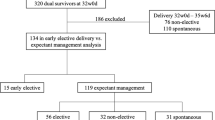Abstract
Septostomy, a rupture of the diamniotic membrane separating monozygotic twins essentially creating a monoamniotic gestation, is a potential therapeutic modality for twin–twin transfusion syndrome (TTTS). This may be associated with complications including cord entanglement or complete rupture of the membranes. We report a case of severe amniotic band syndrome with cord amputation after septostomy. A 33-year-old woman with a Mo-Di twin pregnancy was diagnosed with TTTS at 18 weeks of gestation. Septostomy as well as amnioreduction were performed at 24 weeks of gestation. A repeat cesarean delivery was performed at 31 weeks resulting in a live recipient baby of 1340 g and a dead donor with amniotic band syndrome. The donor showed pieces of membrane tightening both legs. The right thigh became entangled in the bands connecting to the umbilical cord of the live fetus. The umbilical cord of the dead twin was completely amputated, whereas the umbilical cord of the live infant was also entrapped within the amniotic band resulting in small diameter and some degree of stricture. This is the first report of a rare but serious complication following septostomy.
This is a preview of subscription content, access via your institution
Access options
Subscribe to this journal
Receive 12 print issues and online access
$259.00 per year
only $21.58 per issue
Buy this article
- Purchase on Springer Link
- Instant access to full article PDF
Prices may be subject to local taxes which are calculated during checkout



Similar content being viewed by others
References
Jain V, Fisk NM . The twin–twin transfusion syndrome. Clin Obstet Gynecol 2004; 47: 181–202.
Hubinont C, Bernard P, Pirot N, Biard J, Donnez J . Twin-to-twin transfusion syndrome: treatment by amniodrainage and septostomy. Eur J Obstet Gynecol Reprod Biol 2000; 92: 141–144.
Johnson JR, Rossi KQ, O'Shaughnessy RW . Amnioreduction versus septostomy in twin–twin transfusion syndrome. Am J Obstet Gynecol 2001; 185: 1044–1047.
Gray PH, Cincotta R, Chan FY, Soong B . Perinatal outcomes with laser surgery for twin–twin transfusion syndrome. Twin Res Hum Genet 2006; 9: 438–443.
Huber A, Diehl W, Bregenzer T, Hackeloer BJ, Hecher K . Stage-related outcome in twin–twin transfusion syndrome treated by fetoscopic laser coagulation. Obstet Gynecol 2006; 108: 333–337.
Chang YL, Chao AS, Hsu JJ, Chang SD, Soong YK . Selective fetocide reversed mirror syndrome in a dichorionic triplet pregnancy with severe twin–twin transfusion syndrome: a case report. Fetal Diagn Ther 2007; 22: 428–430.
Taylor MJ, Shalev E, Tanawattanacharoen S, Jolly M, Kumar S, Weiner E et al. Ultrasound-guided umbilical cord occlusion using bipolar diathermy for stage III/IV twin–twin transfusion syndrome. Prenat Diagn 2002; 22: 70–76.
Saade GR, Belfort MA, Berry DL, Bui TH, Montgomery LD, Johnson A et al. Amniotic septostomy for the treatment of twin oligohydramnios-polyhydramnios sequence. Fetal Diagn Ther 1998; 13: 86–93.
Adegbite AL, Ward SB, Bajoria R . Perinatal outcome following amniotic septostomy in chronic TTTS is independent of placental angioarchitecture. J Perinatol 2003; 23: 498–503.
Lim YK, Tan TY, Zuzarte R, Daniel ML, Yeo GS . Outcomes of twin–twin transfusion syndrome managed by a specialised twin clinic. Singapore Med J 2005; 46: 401–406.
Saito M, Pontes AL, Porto Filho FA, Sousa FL, Saito M, Araujo JE et al. Septostomy with amniodrainage in the treatment of twin-to-twin transfusion syndrome: a 16-case report. Arch Gynecol Obstet 2007; 275: 341–345.
Moise Jr KJ, Dorman K, Lamvu G, Saade GR, Fisk NM, Dickinson JE et al. A randomized trial of amnioreduction versus septostomy in the treatment of twin–twin transfusion syndrome. Am J Obstet Gynecol 2005; 193: 701–707.
Sebire NJ, Noble PL, Odibo A, Malligiannis P, Nicolaides KH . Single uterine entry for genetic amniocentesis in twin pregnancies. Ultrasound Obstet Gynecol 1996; 7: 26–31.
Megory E, Weiner E, Shalev E, Ohel G . Pseudomonoamniotic twins with cord entanglement following genetic funipuncture. Obstet Gynecol 1991; 78: 915–917.
Torpin R . Amniochorionic mesoblastic fibrous strings and amnionic bands: associated constricting fetal malformations or fetal death. Am J Obstet Gynecol 1965; 91: 65–75.
Donnai D, Winter RM . Disorganisation: a model for ‘early amnion rupture’? J Med Genet 1989; 26: 421–425.
Lockwood C, Ghidini A, Romero R, Hobbins JC . Amniotic band syndrome: reevaluation of its pathogenesis. Am J Obstet Gynecol 1989; 160: 1030–1033.
Seeds JW, Cefalo RC, Herbert WN . Amniotic band syndrome. Am J Obstet Gynecol 1982; 144: 243–248.
Acknowledgements
We thank the babies and their parents for participating in the study. This study was supported by a grant from Health and Labour Sciences Research Grants: Comprehensive Research on Cardiovascular Diseases, no. 17160501 in Japan, which was entitled ‘Cohort study for concept, pathophysiology, establishment of diagnostic criteria, and effective intervention for metabolic syndrome in childhood’.
Author information
Authors and Affiliations
Corresponding author
Rights and permissions
About this article
Cite this article
Rujiwetpongstorn, J., Tongsong, T. Amniotic band syndrome following septostomy in management of twin–twin transfusion syndrome: a case report. J Perinatol 28, 377–379 (2008). https://doi.org/10.1038/sj.jp.7211927
Received:
Revised:
Accepted:
Published:
Issue Date:
DOI: https://doi.org/10.1038/sj.jp.7211927



